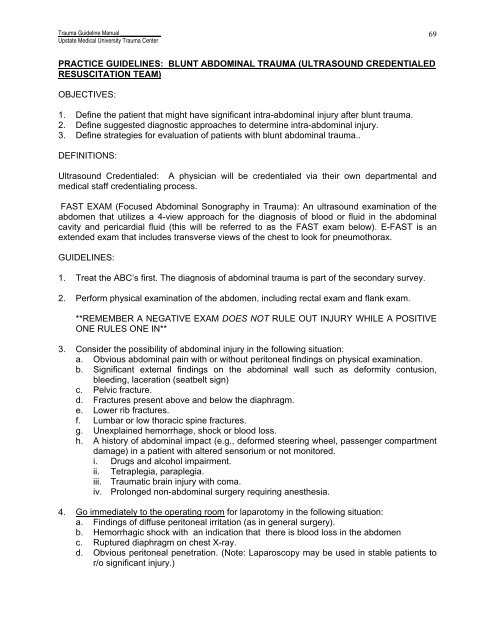Trauma Guideline Manual - SUNY Upstate Medical University
Trauma Guideline Manual - SUNY Upstate Medical University
Trauma Guideline Manual - SUNY Upstate Medical University
You also want an ePaper? Increase the reach of your titles
YUMPU automatically turns print PDFs into web optimized ePapers that Google loves.
<strong>Trauma</strong> <strong>Guideline</strong> <strong>Manual</strong>______________<strong>Upstate</strong> <strong>Medical</strong> <strong>University</strong> <strong>Trauma</strong> Center69PRACTICE GUIDELINES: BLUNT ABDOMINAL TRAUMA (ULTRASOUND CREDENTIALEDRESUSCITATION TEAM)OBJECTIVES:1. Define the patient that might have significant intra-abdominal injury after blunt trauma.2. Define suggested diagnostic approaches to determine intra-abdominal injury.3. Define strategies for evaluation of patients with blunt abdominal trauma..DEFINITIONS:Ultrasound Credentialed: A physician will be credentialed via their own departmental andmedical staff credentialing process.FAST EXAM (Focused Abdominal Sonography in <strong>Trauma</strong>): An ultrasound examination of theabdomen that utilizes a 4-view approach for the diagnosis of blood or fluid in the abdominalcavity and pericardial fluid (this will be referred to as the FAST exam below). E-FAST is anextended exam that includes transverse views of the chest to look for pneumothorax.GUIDELINES:1. Treat the ABC’s first. The diagnosis of abdominal trauma is part of the secondary survey.2. Perform physical examination of the abdomen, including rectal exam and flank exam.**REMEMBER A NEGATIVE EXAM DOES NOT RULE OUT INJURY WHILE A POSITIVEONE RULES ONE IN**3. Consider the possibility of abdominal injury in the following situation:a. Obvious abdominal pain with or without peritoneal findings on physical examination.b. Significant external findings on the abdominal wall such as deformity contusion,bleeding, laceration (seatbelt sign)c. Pelvic fracture.d. Fractures present above and below the diaphragm.e. Lower rib fractures.f. Lumbar or low thoracic spine fractures.g. Unexplained hemorrhage, shock or blood loss.h. A history of abdominal impact (e.g., deformed steering wheel, passenger compartmentdamage) in a patient with altered sensorium or not monitored.i. Drugs and alcohol impairment.ii. Tetraplegia, paraplegia.iii. <strong>Trauma</strong>tic brain injury with coma.iv. Prolonged non-abdominal surgery requiring anesthesia.4. Go immediately to the operating room for laparotomy in the following situation:a. Findings of diffuse peritoneal irritation (as in general surgery).b. Hemorrhagic shock with an indication that there is blood loss in the abdomenc. Ruptured diaphragm on chest X-ray.d. Obvious peritoneal penetration. (Note: Laparoscopy may be used in stable patients tor/o significant injury.)
















